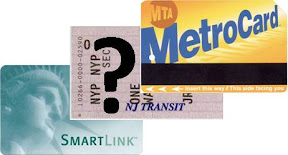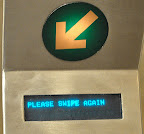Today I offer part three of a series on the Future of the Metro Card and smart card technologies. In case you missed them: Part 1 and Part 2. In order to incorporate a lot of the comments we have received, I have decided to split part three into two parts. Expect an additional Part 4 tomorrow — a proposed Smart Card for NYC.
Part 3 – Smart Card Progress in NYC
As we reported on Monday, Elliot Sander has passed the baton to Jay Walder, Head Wizard of the OysterCard, to lead the MTA into smart-card future. Walder may not be alone — just this morning, Bloomberg called for an MTA technology czar, to keep NYC on the cutting edge in transit technology (which it most certainly is not). Based on the record of his 2001 promises, we should be skeptical this time around — still it’s exciting to see Bloomberg linking his own political success to the future of transit. And in my opinion, a dedicated technology czar could be great news for incredibly delayed projects like Computer-Based Train Control, GPS for buses, and under-ground cellphone service.
As many of you commented on Monday and Tuesday, both the MTA and the Port Authority are no strangers to smart cards. The developments in smart card technology among all agencies, however, have been fragmented, slow, and confusing. Below, I attempt to summarize what each agency has done and synthesize where I believe they are actually headed.
Past Progress
The MTA first launched a contact-less payment system in a pilot on the Lexington Avenue Line in 2006. The project was in partnership with MasterCard, utilizing their PayPass technology — a fancy credit card version of an RFID-enabled smart card, usually in the form of a fob. Early reports were successful, leading to an extension in 2007. Participating credit cards even allowed pay-pass users to use their cellphone as the pass. Although the pilot remains active, the MTA has been fairly mum about the project.
The PortAuthority launched their own smart card, the SmartLink, in 2006. Although riders initally preferred the MetroCard, according to recent reports the SmartLink is now the most popular way to pay on PATH. The SmartLink has many of the benefits of a modern smart card. It is a contact-less system, ensuring speed, and its money value can be controlled online. Its usefulness is limited, of course, by its scope — it has no interoperability with any other system, not even the PA’s own AirTrain systems.
Recent Progress
Perhaps because the PortAuthority recognized the SmartLink’s un-tapped potential (yes, that’s a pun), leaders decided in 2008 to pilot (what I think is) a SmartLink expansion. In February 2008, the Port Authority announced a pilot with NJT “to develop and test a ‘tap’ payment card at all 13 PATH train stations and on two connecting NJ TRANSIT bus routes”. Like the MTA, NJ Transit and the Port Authority chose MasterCard to design and build the system. Although the pilot was expected to “lauch in early 2009“, I have heard nothing about it, and its relationship to the existing SmartLink program remains unclear. Unless one of you can share new information, I can only presume that this pilot is being held up in some long-term development process (aka transit purgatory).
Miraculously, however, the MTA may be able to shed some light. As recently as July 2009, Steve Frazzini, chief fare-payment officer at New York City Transit, told the Philadelphia Daily News (thanks to reader, Scott E for the the correction) that the MTA “will demonstrate a second phase [of the Lexigton Avenue pilot] at year’s end .” According to the same Philly article, Frazzine said that the expanded MTA pilot “will include 275 buses and will link to a pilot with the Port Authority of NY/NJ, PATH and New Jersey Transit.” In other words, the MTA is in fact working with the Port Authority and NJT on a smart card pilot.
Conclusion
The respective agencies are lacking transparency and the media has failed to properly investigate their plans. There has been no press release. There has been no coverage by a NYC-based media outlet. Yet right under our noses, the MTA, NJT, and the Port Authority are (supposedly) in the process of piloting a multi-agency smart card. (Finding out about it in the Philadelphia Daily News is but salt in the wound.)
But since this blog was inspired by the Second Avenue Subway, let’s just say, “I’ll believe it when I see it.”
Stay tuned tomorrow for Part 4 – Smart Card Proposal for NYC. If anyone has any additional sources of information about anything above, please pass it along. Once again, thank you for all of your excellent comments!







 As the MTA gears up to raise fares, two stories about straphangers’ attempts at outsmarting the swipe have made the news this week.
As the MTA gears up to raise fares, two stories about straphangers’ attempts at outsmarting the swipe have made the news this week. 